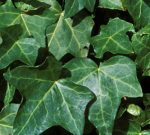 This evergreen climbing vine is a member of the Aralia family, Araliaceae, that also includes Fatsia and Schefflera. It is native to most of Europe and western Asia where it grows in waste spaces and on walls and tree trunks. Growing up to 98’ long, this vine produces aerial rootlets with matted pads that cling tightly to various surfaces. The dark green leaves are waxy and have conspicuous white veins. Young leaves are palmately five-lobed while older leaves on flowering stems in full sun are unlobed and cordate. The small greenish-yellow flowers are produced in umbels up to 2” wide from late summer to late fall and are followed by .3” wide black-purple fruits attractive to wildlife. English ivy is considered invasive in many areas and can do serious damage to stucco, wood, brick mortar, and aluminum siding. It is tolerant of shade and dry conditions so makes a good ground cover in difficult sites and is also attractive growing on trellises, fences, and walls. Many cultivars are available that are less vigorous than the species and make excellent houseplants and topiary. The genus name, Hedera, is the ancient Latin name for ivy and comes from the Greek word χανδάνω (khandánō) meaning to grasp referring to the aerial rootlets with matted pads by which the vine climbs. The specific epithet, helix, is the ancient Greek word ἕλιξ (elix), meaning spiral and refers to the growth pattern.
This evergreen climbing vine is a member of the Aralia family, Araliaceae, that also includes Fatsia and Schefflera. It is native to most of Europe and western Asia where it grows in waste spaces and on walls and tree trunks. Growing up to 98’ long, this vine produces aerial rootlets with matted pads that cling tightly to various surfaces. The dark green leaves are waxy and have conspicuous white veins. Young leaves are palmately five-lobed while older leaves on flowering stems in full sun are unlobed and cordate. The small greenish-yellow flowers are produced in umbels up to 2” wide from late summer to late fall and are followed by .3” wide black-purple fruits attractive to wildlife. English ivy is considered invasive in many areas and can do serious damage to stucco, wood, brick mortar, and aluminum siding. It is tolerant of shade and dry conditions so makes a good ground cover in difficult sites and is also attractive growing on trellises, fences, and walls. Many cultivars are available that are less vigorous than the species and make excellent houseplants and topiary. The genus name, Hedera, is the ancient Latin name for ivy and comes from the Greek word χανδάνω (khandánō) meaning to grasp referring to the aerial rootlets with matted pads by which the vine climbs. The specific epithet, helix, is the ancient Greek word ἕλιξ (elix), meaning spiral and refers to the growth pattern.
Type: Evergreen climbing vine
Bloom: Umbels of greenish-yellow flowers in late summer to late fall
Size: Up to 98′ long
Light: Part to full shade
Soil: Average, medium moist, well-drained; drought tolerant
Hardiness: Zones 4-9
Care: Prune to protect surrounding vegetation from suffocation.
Pests and Diseases: Aphids, caterpillars, loopers, mealybugs, mites, scale; bacterial leaf spot, canker, leaf spot, powdery mildew, stem rot
Propagation: Semi-hardwood cuttings, seed
Companion Plants: Euonymous fortune ‘Emerald ‘n’ Gold’, Cotinus coggyria,
Outstanding Selections:
‘Anne Marie’ (creamy edges)
‘Ivalace’ (curly leaves)
‘Gold Child’ (golden variegation)
‘Needlepoint’ ( leaves with sharply pointed lobes)